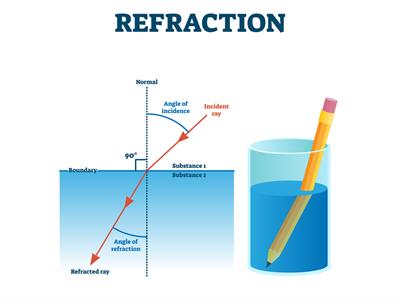PDF chapter test TRY NOW
In a transparent medium, light appears to travel in straight lines.
What happens when light passes through one transparent medium and into another?
Is it still moving in a straight line, or has it changed its course?
We will discuss about some of our everyday experiences in order to answer these questions.
You may have noticed that the bottom of a water-filled tank or pond appears to be raised. The letters appear raised when a thick glass slab is placed over printed matter and viewed through the glass slab.
What is the reason behind this?
Have you ever seen a pencil in a glass tumbler partially submerged in water?
It appears to be displaced at the air-water interface.
You may have noticed that when viewed from the sides of a glass tumbler containing lemon appears to be larger than it is.
How do you explain such occurrences?

Pencil submerged in water.
Consider the case of a pencil that appears to be displaced while partially submerged in water. The light that reaches you from the part of the submerged pencil appears to come from a different direction than the light that reaches you from the part of the pencil above water. The pencil appears to be displaced at the interface as a result of this.
The letters appear to be raised for similar reasons when viewed through a glass slab placed over it.
If we use liquids like kerosene or turpentine instead of water, does a pencil appear to be displaced to the same extent?
Will the letters appear to rise to the same height if a glass slab is replaced with a transparent plastic slab?

Viewing the letters through glass
You will notice that the magnitude of the effect varies depending on the media pairs. Light does not travel in the same direction in all media, according to these findings. When light travels obliquely from one medium to another, it appears that the direction of light propagation in the second medium changes. This phenomenon is known as the Refraction of light.
